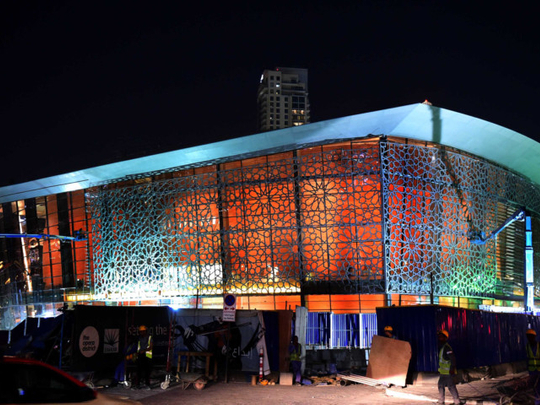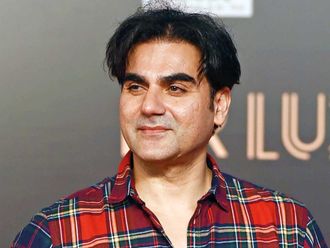
The cultural nerve centre of Dubai’s ambitious vision, the Dubai Opera is an architectural feat that is shifting the paradigms of what an opera house can do for its community.
Set in an open-air plaza that will host public theatre, workshops, cafes and retail, the relatively low height opera house offers polite contrast to the gnarling high-rise buildings around it. In opposition to the impersonal scale most buildings in the region imply, Dubai Opera, with its sinuous profile that complements the lake behind, intends to reset our line of vision and sense of scale to one that is intimate and communal.
“We want visitors who come to the opera house to activate the plaza and the neighbourhood,” said architect Janus Rostock, regional design director at WS Atkins, the mastermind behind the emirate’s first purpose-built performing arts centre. Through an angular profile and the use of specialised anti-reflective glass, he intends to blur the lines between the interior and the plaza, affording crystal clear views into and from the building at any time of day, or night.
The Dubai Opera house in Downtown Dubai. Zarina Fernandes/Gulf News
“The lobby itself is a public space, only demarcated by a glass screen and external wooden louvres that provide protection from the sun,” he says.
This design intervention, which will allow the lobby and public realm to integrate into one space, serves a larger purpose — bringing visitors, neighbours and passers-by from all walks of life together, even if for a moment, for an ever-evolving theatre of life.
Architecture’s highest purpose indeed lies in serving its community, but when there are functional logistics — like green rooms and AV control rooms — it takes an integrated approach to building and technological design to ensure ambitious concepts are not lost to reality. For a venue with 21 dressing rooms, a fully open facade accessible to pedestrians was a challenge. To not compromise on concept and deliver the first show within nearly three years (the project broke ground in May 2013) demanded a team effort. The architectural team at WS Atkins led, drawing heavily on engineering disciplines.
A chandelier dominates the Opera’s lobby as the finishing touches are put on. The opening night performance is by Placido Domingo. Zarina Fernandes/Gulf News
As the project edges close to its grand opening, the arabesque lattice work — the lowest common denominator of all Emaar buildings — is in place to welcome the first hoard of visitors come August 31.
While the opera house, with its dhow-inspired form, tips its hat to the region’s maritime history, the functional elements inside are very much of the times. Thanks to cutting-edge hydraulic technology, moving floor plates and a series of overhead reflectors, the functional configuration of the internal space ranges from a concert hall setting for 1,901 people to a theatre with 1,875 seats; box seating offers additional room. In the “flat floor” mode, the building is designed to host a wide variety of events including weddings, trade shows, exhibitions and banquets seating up to 1,000 guests.
This flexibility that enables a balance between high-art events and those of a more commercial nature empowers Dubai Opera to sustain itself financially and not depend on subsidies that have traditionally supported opera house the world over.
The Dubai Opera house in Downtown Dubai. Zarina Fernandes/Gulf News
At the roof of the 5,798 sqm building is a lounge with a restaurant, a small stage for performances, and unparalleled views of the Dubai Fountains and Burj Khalifa. “Cold air is pumped to the roof courtyard, so even in summer people be able to enjoy that outdoor experience,” Rostock said earlier this year. “We’ve also incorporated a conservatory at the rooftop level.”
Offering state-of-the-art acoustics, the sound systems are designed for easy programming for shows and the building’s various performance modes. Add to that more than 600 lighting fixtures — including a specially commissioned Lasvit chandelier that weighs 5,000kg and an amber-hued internal shell that lights up the night sky — all rigged to offer transformative lighting experiences, the Dubai Opera exceeds on technological infrastructure expected from buildings of its nature.
While the workings of an opera house have changed very little in the past hundred years — and in that, Dubai Opera shares similarities with many of the world’s greatest venues — it is in its technology-enabled transformative quality, and its regard towards incorporating users and the general public, that the project shines a light of its own. For a city that has almost everything man could wish for, the opera house offers us an opportunity to learn about and interact with performing arts, diversity and each other. I hope that people use Dubai Opera for more than an excuse for a lavish night out; it is obviously meant to play a greater role.
— Pratyush Sarup is design manager at one of the UAE’s premium interiors firms. He writes twice a month on design, in tabloid! on Saturday.














